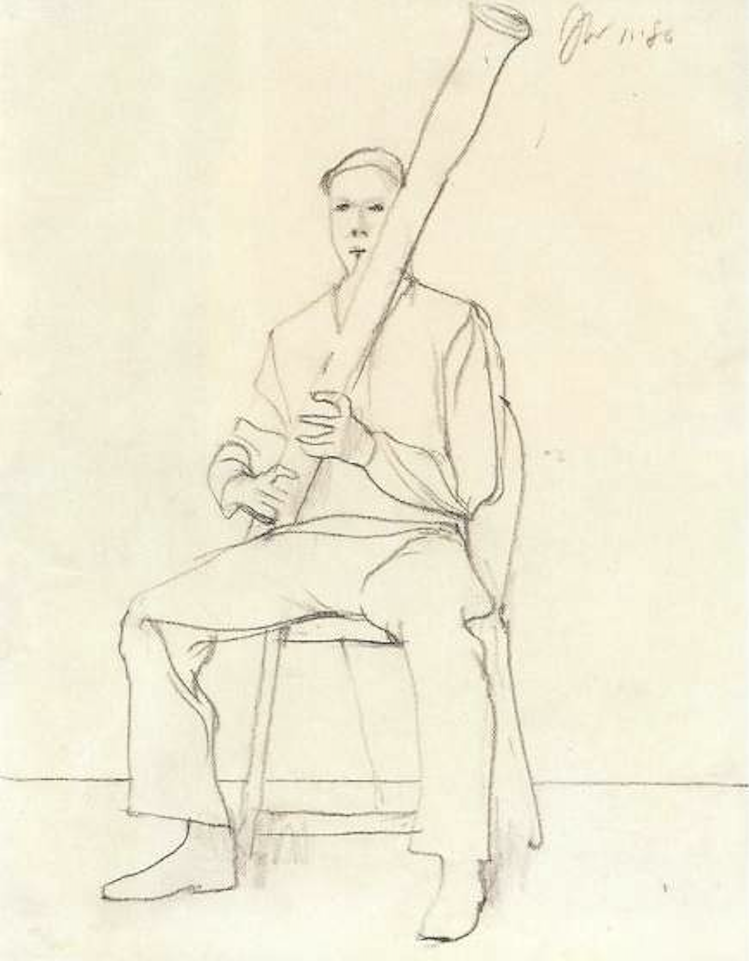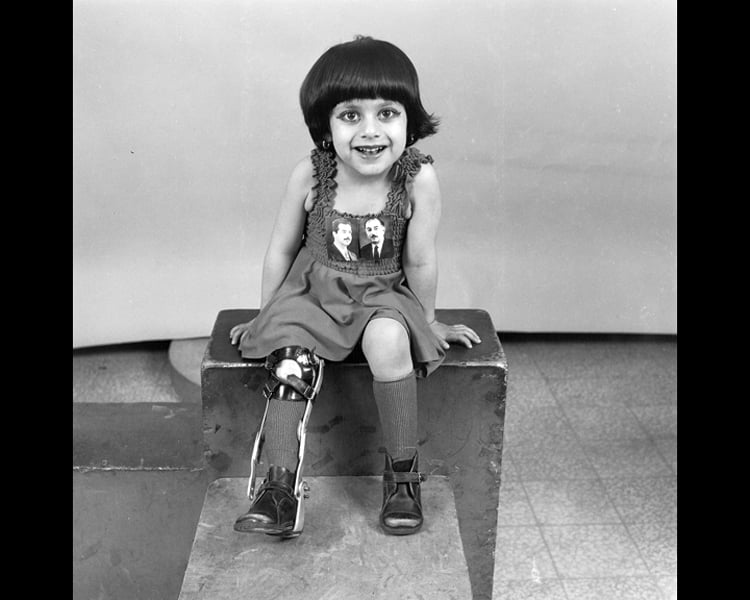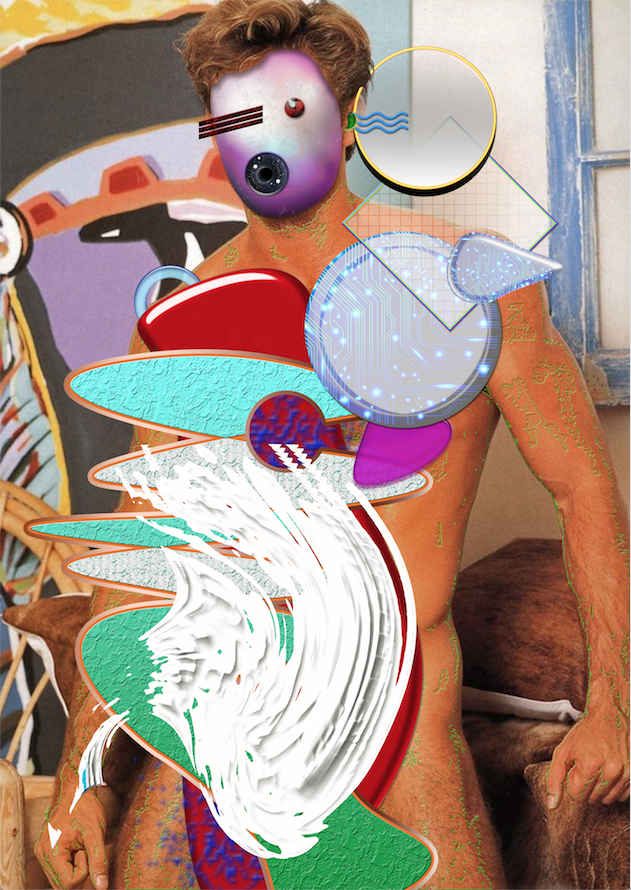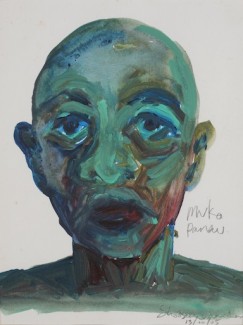
© » KADIST
Ian Cheng
Ian Cheng’s project 3FACE is based on a model that is derived from both the artist’s extensive readings on psychology and cognition, and his own intuitive understanding of how people function. 3FACE positions the process of minting a generative NFT as a metaphor for personality development. While part of a series, because of the responsive coding, each NFT is unique and is informed by the contents of the owner’s wallet.

© » KADIST
Gauri Gill
Bhanwari and Lichhma from the Balika Mela series by Gauri Gill explores human expression through the medium of photography, bringing questions of agency, the role of photography, and feminism together through its portraits of adolescent girls from rural Rajasthan, India. Balika Mela is an annual fair for girls aimed at uplifting a population severely maligned in Rajasthan. Having set up a stall in this fair, Gill invited local girls to voluntarily pose for photographs which they were allowed to keep, expressing their performative individuality.

© » KADIST
Ian Cheng
Ian Cheng’s project 3FACE is based on a model that is derived from both the artist’s extensive readings on psychology and cognition, and his own intuitive understanding of how people function. 3FACE positions the process of minting a generative NFT as a metaphor for personality development. While part of a series, because of the responsive coding, each NFT is unique and is informed by the contents of the owner’s wallet.

© » KADIST
Ian Cheng
Ian Cheng’s project 3FACE is based on a model that is derived from both the artist’s extensive readings on psychology and cognition, and his own intuitive understanding of how people function. 3FACE positions the process of minting a generative NFT as a metaphor for personality development. While part of a series, because of the responsive coding, each NFT is unique and is informed by the contents of the owner’s wallet.

© » KADIST
Ian Cheng
Ian Cheng’s project 3FACE is based on a model that is derived from both the artist’s extensive readings on psychology and cognition, and his own intuitive understanding of how people function. 3FACE positions the process of minting a generative NFT as a metaphor for personality development. While part of a series, because of the responsive coding, each NFT is unique and is informed by the contents of the owner’s wallet.

© » KADIST
Mohamed Bourouissa
Drawing & Print (Drawing & Print)
In his photographic series Périphérique (2005–2008), Mohamed Bourouissa used the composition of classical paintings to stage the portrait of friends and young people in the banlieue s (suburbs). He states “by deconstructing the clichés surrounding this subject, I deal with the problematic power struggle and its mechanics.” This series follows various themes explored throughout the work of Bourouissa. For Temps Morts, his first film, he depicted a yearlong series of mobile phone exchanges with someone in prison.

© » KADIST
Mike Cloud
In his series Hanging and Beheading Paintings Mike Cloud speaks to the suffering of a series of named (and occasionally unnamed) individuals, addressing their trauma within the language of abstraction. They offer the viewer an aesthetic account of individuality, death, and the empathic space of communion in absence via avant-garde portraiture, unbound by the rules of anatomy or even representation, but instead by purely expressive compositional and aesthetic goals. Untitled (Beheading) embraces the individual subjectivities of notable and mundane contemporaries — from pop stars to serial killers — in cryptic ways, connected only by the physical circumstances of their deaths.

© » KADIST
Gisela McDaniel
Got Your Back by Gisela McDaniel depicts two women of color from different ethnic backgrounds who share similar violent experiences. However, the sitters never met and were depicted separately by artist Gisela McDaniel. The painting is thus an artificial construct, whose warm, gentle and seemingly benign look Is undermined by the accompanying soundtrack detailing their horrific experiences.

© » KADIST
Phan Quang
Phan Quang’s portrait series Re/cover grapples with a lesser-known history in Vietnam. After World War II, many Japanese soldiers who fought in Vietnam stayed in the country. They married Vietnamese women, had children, and lived in the country until Japan recalled them home.

© » KADIST
rafa esparza
thanks for staying alive Fern.1994 by rafa esparza is from a body of work that pays homage to youth culture in the 90s. The work is based on the popularity of mid-90s era Star Shots photographs, which usually featured graphic backgrounds and highly glamorized subjects wearing heavy makeup, matching outfits, perfectly coiffed hair, and dramatic expressions. In Los Angeles, esparza remembers many Black and Brown youths going to the mall (where many Star Shots photo studios were located) to circulate the photos with personal messages written on the back.

© » KADIST
Shooshie Sulaiman
Drawing & Print (Drawing & Print)
Shooshie Sulaiman’s pictures of unidentified figures initially appear alien and even monstrous: rendered hairless in unusual and even sickly colors, they stand in stark contrast to the aesthetic ideals of conventional portraiture. The subject in Dulu atas pedestal, sekarang dalampedestal / Before on pedestal, now inside (2005), a ball point pen and charcoal rendering of a bald figure with a wide-eyed stare, appears caught in a distressingly static state, at once both uncomfortable and yet incapable of ameliorating his condition. Sulaiman’s subject here becomes an almost frightening sight, the emotive brush strokes replaced by the ball point pen’s erratic black lines, the eyes and mouth scribbled over in a deliberately defacing gesture.

© » KADIST
Shooshie Sulaiman
Shooshie Sulaiman’s pictures of unidentified figures initially appear alien and even monstrous: rendered hairless in unusual and even sickly colors, they stand in stark contrast to the aesthetic ideals of conventional portraiture. The green acrylic paint used for the subject’s skin in Maka Panau / Tinea Vesicolor (2005), for example, evokes cultural associations between phenotype and diseases such as hypochromic anemia, a blood-related illness historically diagnosed by the green-hued tone it produced in a patient’s pallor. Staring at the viewer a forlorn gaze, Sulaiman’s subject appears caught in a distressingly static state, at once both uncomfortable and yet incapable of ameliorating his condition.

© » KADIST
Akram Zaatari
“The two men were relatives and both were in the Lebanese Army.” Hashem El Madani. Hashem El Madani, a studio photographer in Saida, began working in 1948. Like all studio photographers his subjects came to him.
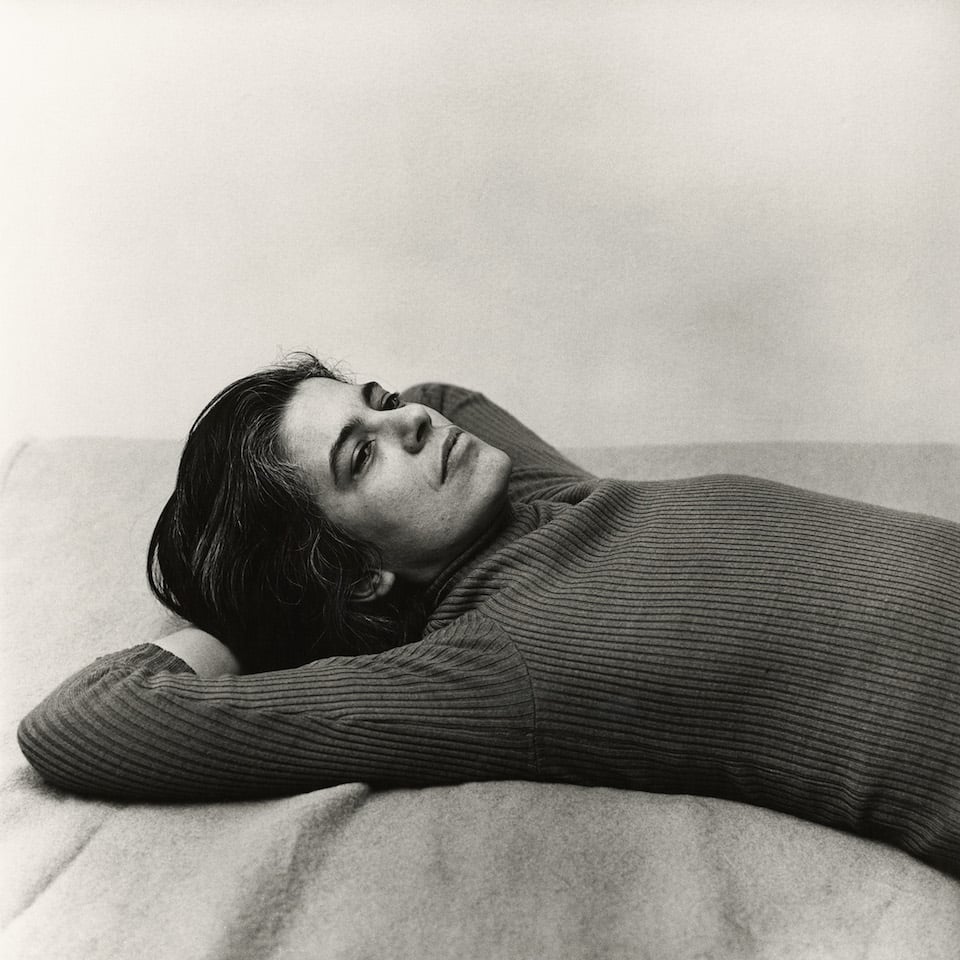
© » KADIST
Peter Hujar
Susan Sontag, the author of On Photography and Regarding the Pain of Others, was captured through Hujar’s now-iconic photograph in a relaxed yet pensive pose. A friend and supporter of his work as well as his subject, Sontag wrote the introduction for Hujar’s only book published during his lifetime: Portraits in Life and Death.

© » KADIST
Akram Zaatari
“People often asked if they could pose with the Kodak advertisement where a full scale woman is featured with a camera offering Kodak rolls. They invented the poses, the gestures and situations.” Hashem El Madani. Hashem El Madani, a studio photographer in Saida, began working in 1948.

© » KADIST
Collier Schorr
Collier Schorr’s prints upend conventions of portrait photography by challenging what it means to “document” a subject. American Flag (Scratch) (1999), for example, depicts an unidentified male subject clad in an American flag-print singlet. With his head and extremities out of frame, the camera focuses on his flush-red torso, his left nipple protruding from the singlet’s strap.

© » KADIST
Akram Zaatari
“While taking the picture it was challenging to make the boys sit properly without moving. Sometimes a member of the family whould hide behind, holding the child.” Hashem El Madani. Hashem El Madani, a studio photographer in Saida, began working in 1948.
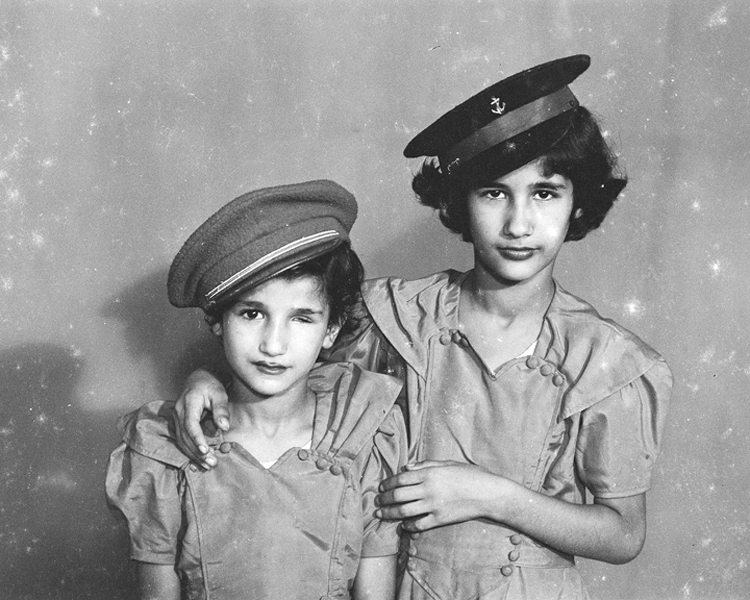
© » KADIST
Akram Zaatari
Hashem El Madani, a studio photographer in Saida, began working in 1948. Like all studio photographers his subjects came to him. The studio was a constant flux of visitors.

© » KADIST
Akram Zaatari
“People often asked if they could pose with the Kodak advertisement where a full scale woman is featured with a camera offering Kodak rolls. They invented the poses, the gestures and situations.” Hashem El Madani. Hashem El Madani, a studio photographer in Saida, began working in 1948.

© » KADIST
Martin Kippenberger
Drawing & Print (Drawing & Print)
7″ Single ‘Pop In’ by Martin Kippenbergher consisting of a vinyl record and a unique artwork drawn by the artist on the record’s sleeve. In the foreground of the album’s cover, a drawing of an empty, round vessel is framed underneath the text “POP IN”, suggesting an invitation to listen to the record, a nod to pop music, or perhaps a literal proposal to enter the vessel or the work. In the background, partly hidden by the round form, Kippenberger’s hand-drawn self portrait glares back at the viewer.

© » KADIST
Jonathan Monk
Untitled (rolled up) , is an abstract portrait of Owen Monk, the artist’s father and features an aluminum ring of 56.6 cm in diameter measuring 1.77 cm in circumference, the size of his father. Jonathan Monk bridges a conceptual art and his family privacy, and ironically ensures that there is “no difference between Sol Lewitt and my mother, he does not know more than she do not know. ” What is the status of the O-backed chair rail to the white cube?
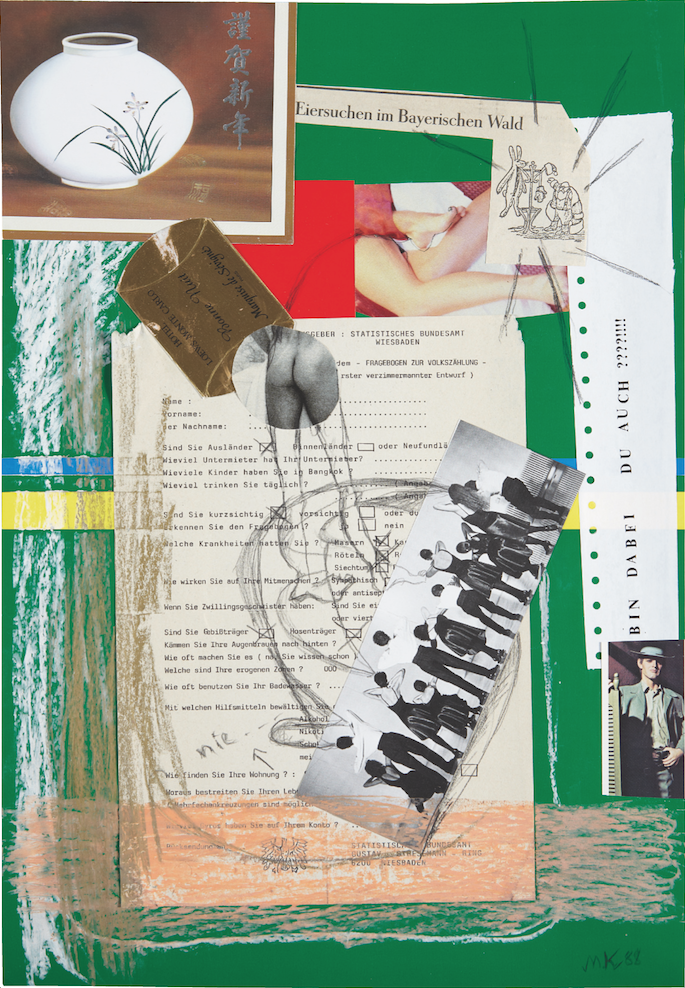
© » KADIST
Martin Kippenberger
Martin Kippenberger’s late collages are known for incorporating a wide range of materials, from polaroids and magazine clips to hotel stationery, decals, and graphite drawings. Untitled is a collage on paper work by Kippenberger that typifies his everything-goes approach: a barely discernible, sliced image of Michael Jackson’s face is overlaid and woven with strips and triangular shapes from a different source into a single composition. Blue tones come from torn out pages of a book where fragments of illustrations can be seen.

© » KADIST
Martin Kippenberger
Drawing & Print (Drawing & Print)
Untitled is a work on paper by Martin Kippenberger comprised of several seemingly disparate elements: cut-out images of a group of dancers, a japanese ceramic vase, and a pair of legs, are all combined with gestural, hand-drawn traces and additional elements such as a candy wrapper from a hotel in Monte Carlo and a statistical form from a federal government office in Wiesbaden, Germany. Text cut out from a Newspaper spells out in German “Egg hunting in the Bavarian forest” and an additional piece of text reads in all capitals “BIN DABEI DU AUCH” (“I’m here too” in English). Together, all the messages and geographies from the separate elements suggest an alternative, highly stylized portrait of the artist; in this case, a fragmented, fluid, and itinerant sense of identity.

© » KADIST
Dinh Q. Lê
Hill of Poisonous Trees (three men) (2008) exemplifies the artist’s signature photo-weaving technique, in which he collects diverse found photographs—portraits of anonymous people, stills from blockbuster films, or journalistic images—cuts them into strips, and weaves them into new composition. The title of the series is translated from the Khmer phrase Tuol Sleng , which literally means a poisonous hill or a place on a mound to keep those who bear or supply guilt, and the photographs came from the Tuol Sleng Genocide Museum in Cambodia, a former prison where at least 200,000 Cambodians were executed during the reign of the Khmer Rouge between 1975 and 1979. In this particular image, three men stand against the backdrop of what looks like a prison interior.

© » KADIST
Tacita Dean
The photographic quality of the film Baobab is not only the result of a highly sophisticated use of black and white and light, but also of the way in which each tree is characterized as an individual, creating in the end a series of portraits. The monumental and unnatural aspect of the baobabs turns them into strange and anthropomorphic personalities. Adding to the descriptive aspect of the film, the sound is a recording of the environment, of sounds made by animals, and participates in this peaceful contemplation.

© » KADIST
Catherine Opie
Catherine Opie’s candid photograph Cathy (bed Self-portrait) (1987) shows the artist atop a bed wearing a negligee and a dildo; the latter is attached to a whip that she holds in her teeth. Opie is known for her honest portraits of diverse individuals, from LGBT people to football players, and the self-portrait has also been a long-standing and important part of her practice. Instead of hiding her sexuality and interest in sadomasochism, Opie wears it proudly.
Akram Zaatari
- location: Sayda, Al-Lubnan
- year born: 1966
- gender: male
- nationality: Lebanese
Ian Cheng
The work of Ian Cheng explores evolutionary processes, including mutation and adaptation in response to changing conditions...
Martin Kippenberger
- location: Vienna, Austria
- year born: 1953
- gender: male
- nationality: German
- home town: Dortmund, Germany
Shooshie Sulaiman
Shooshie Sulaiman is one of the leading creative practitioners in Southeast Asia...
Catherine Opie
- location: Los Angeles, California
- year born: 1961
- gender: female
- nationality: American
- home town: Sandusky, Ohio
Peter Hujar
Before American photographer Peter Hujar passed away from AIDS in 1987, he was a part of a group of New York-based artists, writers, and musicians who defined the downtown scene in the 1970s...
rafa esparza
rafa esparza is a multidisciplinary artist whose work reveals his interests in history, personal narratives, kinship, colonization, and the disrupted genealogies it produces...
Mohamed Bourouissa
Mohamed Bourouissa became known in the 2000s with a series of photographs on young people in the suburbs of Paris...
Elina Brotherus
Elina Brotherus depicts, through her photographic work a portrait of the contemporary artist made during different artistic residencies...
Phan Quang
Visual artist and photographer Phan Quang stages nuanced compositions that illustrate the relationship between global historical events and the personal histories of families and communities in Vietnam...
Philip-Lorca diCorcia
The works of Philip-Lorca diCorcia oscillate between two possible definitions of photography – from a recording system in the tradition of documentary and a system of representation in the tradition of fiction...
Gisela McDaniel
Chamorro artist Gisela McDaniel depicts Native American and mixed-race women from the USA’s former, as well as current, Pacific territories...
James Weeks
James Weeks, born in 1922, was an important figure in the Bay Area figurative painter tradition, with contemporaries such as Richard Diebenkorn, Elmer Bischoff, and David Park...
Mike Cloud
Artist Mike Cloud builds irregularly shaped canvases and frames into unique sculptural objects...
Jonathan Monk
- location: Berlin, Germany
- year born: 1969
- gender: male
- nationality: British
- home town: Leicester, United Kingdom
Tacita Dean
- location: Berlin, Germany
- year born: 1965
- gender: female
- nationality: British
- home town: Canterbury, United Kingdom
Gauri Gill
Gauri Gill is interested in the social contract of photography...
-
1950-1959
Akram Zaatari
1950“While taking the picture it was challenging to make the boys sit properly without moving...
Akram Zaatari
1956“People often asked if they could pose with the Kodak advertisement where a full scale woman is featured with a camera offering Kodak rolls...
-
1960-1969
Akram Zaatari
1966“People often asked if they could pose with the Kodak advertisement where a full scale woman is featured with a camera offering Kodak rolls...
-
1970-1979
Akram Zaatari
1972“The two men were relatives and both were in the Lebanese Army.” Hashem El Madani...
Peter Hujar
1975Susan Sontag, the author of On Photography and Regarding the Pain of Others, was captured through Hujar’s now-iconic photograph in a relaxed yet pensive pose...
-
1980-1989
Catherine Opie
1987Catherine Opie’s candid photograph Cathy (bed Self-portrait) (1987) shows the artist atop a bed wearing a negligee and a dildo; the latter is attached to a whip that she holds in her teeth...
Martin Kippenberger
1988Martin Kippenberger’s late collages are known for incorporating a wide range of materials, from polaroids and magazine clips to hotel stationery, decals, and graphite drawings...
Martin Kippenberger
Drawing & Print
1989(Drawing & Print) 7″ Single ‘Pop In’ by Martin Kippenbergher consisting of a vinyl record and a unique artwork drawn by the artist on the record’s sleeve...
Martin Kippenberger
Drawing & Print
1989(Drawing & Print) Untitled is a work on paper by Martin Kippenberger comprised of several seemingly disparate elements: cut-out images of a group of dancers, a japanese ceramic vase, and a pair of legs, are all combined with gestural, hand-drawn traces and additional elements such as a candy wrapper from a hotel in Monte Carlo and a statistical form from a federal government office in Wiesbaden, Germany...
-
1990-1999
Collier Schorr
1999Collier Schorr’s prints upend conventions of portrait photography by challenging what it means to “document” a subject...
-
2000-2009
Tacita Dean
2001The photographic quality of the film Baobab is not only the result of a highly sophisticated use of black and white and light, but also of the way in which each tree is characterized as an individual, creating in the end a series of portraits...
Gauri Gill
2003Bhanwari and Lichhma from the Balika Mela series by Gauri Gill explores human expression through the medium of photography, bringing questions of agency, the role of photography, and feminism together through its portraits of adolescent girls from rural Rajasthan, India...
Jonathan Monk
2003Untitled (rolled up) , is an abstract portrait of Owen Monk, the artist’s father and features an aluminum ring of 56.6 cm in diameter measuring 1.77 cm in circumference, the size of his father...
Shooshie Sulaiman
Drawing & Print
2005(Drawing & Print) Shooshie Sulaiman’s pictures of unidentified figures initially appear alien and even monstrous: rendered hairless in unusual and even sickly colors, they stand in stark contrast to the aesthetic ideals of conventional portraiture...
Shooshie Sulaiman
2005Shooshie Sulaiman’s pictures of unidentified figures initially appear alien and even monstrous: rendered hairless in unusual and even sickly colors, they stand in stark contrast to the aesthetic ideals of conventional portraiture...
Dinh Q. Lê
2008Hill of Poisonous Trees (three men) (2008) exemplifies the artist’s signature photo-weaving technique, in which he collects diverse found photographs—portraits of anonymous people, stills from blockbuster films, or journalistic images—cuts them into strips, and weaves them into new composition...
-
2010-2019
Phan Quang
2013Phan Quang’s portrait series Re/cover grapples with a lesser-known history in Vietnam...
Mohamed Bourouissa
Drawing & Print
2017(Drawing & Print) In his photographic series Périphérique (2005–2008), Mohamed Bourouissa used the composition of classical paintings to stage the portrait of friends and young people in the banlieue s (suburbs)...
-
2020-2029
Mike Cloud
2020In his series Hanging and Beheading Paintings Mike Cloud speaks to the suffering of a series of named (and occasionally unnamed) individuals, addressing their trauma within the language of abstraction...
Gisela McDaniel
2020Got Your Back by Gisela McDaniel depicts two women of color from different ethnic backgrounds who share similar violent experiences...
rafa esparza
2020thanks for staying alive Fern.1994 by rafa esparza is from a body of work that pays homage to youth culture in the 90s...

